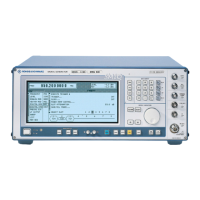SMIQ Fading Simulation
1125.5555.03 2.81 E-9
2.9.4.3 Menu MOVING DELAY
In the MOVING DELAY mode, the Fading Simulator simulates the dynamic propagation conditions
according to test case 3GPP, 25.104-320, Annex B3.
2 paths are simulated; the delay of path 1 remains unchanged, the delay of path 2 slowly moves to and
fro sinusoidally. The two paths have no fading profile (non-fading), have the same level, the same phase
and have no Doppler shift.
t
P
2
∆τ
P
1
t
Fig. 2-42 Two paths with menu MOVING DELAY
The delay of the moving path is obtained with the following equation:
÷
÷
ø
ö
ç
ç
è
æ
÷
÷
ø
ö
ç
ç
è
æ
⋅
++= )
PERIOD_VARIATION
t2
sin(1
2
VARIATION_DELAY
MEAN_DELAY
π
τ∆
The following settings are required to obtain the values suggested in Annex B3:
DELAY (
path 1)
1
µs
DELAY MEAN
= DELAY(
path 1) + DELAY VARIATION / 2 = 3.5µs
DELAY VARIATION
5
µs
VARIATION PERIOD 157 s
For further tests, DELAY MEAN and the variation parameters can be modified. The two paths can be
levelled differently.
Fig. 2-43 Menu MOVING DELAY
STATE
Activating/deactivating the moving delay simulation.
IEC/IEEE-bus command :SOUR:FSIM:MDEL:STAT ON | OFF
IGNORE RF
CHANGES < 5%
When switched on, frequency variations below 5% are ignored. RF hopping is
thus faster than 3 ms. IEC/IEEE-bus command :SOUR:FSIM:IGN:RFCH ON
STANDARD
Is now the same as SET DEFAULT.

